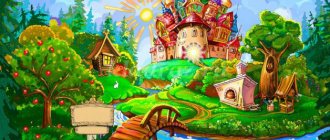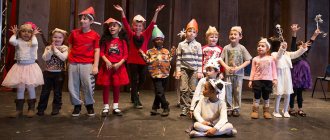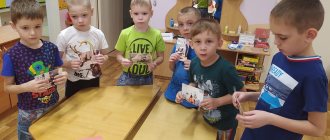Construction and construction games. Features of organization in different age groups
Construction games are practical activities aimed at obtaining a specific, pre-conceived product. Children's construction is closely related to play and is an activity that meets the interests of the child.
Constructive activity is a form of child activity that develops spatial thinking, forms the ability to foresee future results, provides an opportunity for the development of creativity, and enriches speech.
Construction from various materials: building material; waste (boxes, reels, foam); natural (seeds, leaves, chestnuts).
In preschool pedagogy, construction is considered as a means of all-round development of the child.
a) Mental development: sensory abilities are formed. By constructing, the child learns to distinguish the external qualities of an object or sample (shape, size, structure, etc.); he also develops cognitive and practical actions. In design, the child, in addition to visual perception of the quality of the object, actually, practically disassembles the sample into parts, and then assembles them into a model (this is how he carries out both analysis and synthesis in action).
Interest in technology is formed, observation skills develop; acquire technical knowledge and become familiar with the properties of geometric bodies.
b) Labor education: playing with building materials prepares children for work: the ability to set goals; plan your work, select the necessary material, critically evaluate the results of your work and the work of your comrades, take a creative approach to achieving your goal. Diligence, independence, initiative, responsible attitude to business, and teamwork develop.
c) Development of speech: in games with building materials, a large role is played by the activity of the hand, associated with the active work of consciousness. Thanks to the joint activity of the hand, brain and speech apparatus, a person has the opportunity to influence the outside world, learning the laws of its development. Construction games help children improve their speech: they share their ideas, explain their actions, and suggest this or that solution. The vocabulary is expanding.
d) Physical education: constant exercise in a wide variety of movements, accompanied by emotional uplift, helps to ensure that these movements become fast, dexterous, and easily subject to eye control. Coordinated work of individual muscles (flexors, extensors).
e) Aesthetic education: with their help, children have the opportunity to develop artistic taste, evoke aesthetic pleasure when looking at beautiful buildings, develop the ability to appreciate what has been created by the creative work of people, love the architecture of their city, country, and take care of them.
f) Moral education: promotes the formation of such valuable qualities as independence, initiative, organization and responsibility when performing a task. During construction classes and play, children are taught willpower, restraint, the ability to listen to the teacher’s explanations and work in accordance with his instructions, to overcome difficulties in achieving the goal.
g) Preparing children for school: promotes the formation of the ability to learn, reveals to them that the main meaning of activity is not only in obtaining results, but also in acquiring knowledge and skills. Such a cognitive motive causes significant changes in mental processes: in the ability to voluntarily control one’s cognitive processes (direct them to solve educational problems), in achieving a certain level of development of mental operations, and the ability to systematically perform mental work necessary for the conscious assimilation of knowledge.
Types of design:
a) Construction from building materials:
cubes, bricks. From these details, children display familiar objects in their buildings. More often used in younger groups.
b) Construction from paper and additional materials: e
This type of design is taught in the middle, senior and preparatory groups. Make a three-dimensional toy out of paper or thin cardboard. Crafting toys using a variety of boxes, reels, corks, pieces of foam, rocks, etc. All this is much more complicated than constructing buildings from individual ready-made forms by composing them.
c) Construction from natural materials: n
Starting with the middle group, chestnut fruits, pine and spruce cones, alder shells, bark, branches, twigs, straw, acorns, etc. are used for construction. The peculiarity of making toys from natural material is that its natural shape is used.
First junior group: Construction games with toys, classes with building materials, during which the necessary actions are taught and the formation of simple, but clear and lasting skills occurs. Children are introduced to building materials, their shape, size, different locations on the table plane (lying, standing); they are taught to stack one on top of the other, place bricks horizontally (train, path); form the simplest ceilings (gates, houses). The teacher finds similarities between buildings and familiar objects in the surrounding life.
Second junior group: They learn not only to distinguish the main building parts (cube, brick, plate), but also to name them, as well as place the bricks at equal distances from each other in a circle, along a quadrangle (fence, fence), placing them on a smaller one plane. They begin to teach purposeful examination of objects and buildings. Teacher's guidance - creating a play environment - selecting building materials.
Middle group: Further development of children's interest in construction games, using created buildings in role-playing games, developing the ability to build not only according to the proposed model, but also the topic outlined by themselves, learning more complex work techniques. Under the guidance of a teacher, children are able to reflect impressions of their surroundings in construction games. They are given a variety of materials (building material; construction sets; pieces of plywood, cardboard, material for decorating buildings), and their ideas about the environment, which they use in the game, expand.
Senior group: Teaching children preliminary planning of collective construction games, setting the goal of the game, identifying participants by preliminary agreement, using constructive and construction skills not only using a visual example, but also drawings and photographs of various structures. Game management is aimed at a combination of intellectual and practical activities. The teacher teaches them to think about upcoming game actions, compare one with another, develops intelligence, encourages guessing, and encourages them to implement the decision they make.
Preparatory group: Construction games are distinguished by more diverse designs, as children become more familiar with the phenomena of life around them, with construction techniques on special excursions, while watching movies, through books. In games, they often imitate the construction activities of adults. The teacher must have the necessary knowledge and show interest in technology and invention. From a wide variety of buildings, structures, types of construction, he selects a little that is accessible to children and has an educational and training effect.
The main ways to implement the management of construction games for preschoolers
Construction games and their optimal organization are necessary for the development of preschoolers. They are focused on the educational development of children, on developing their constructive skills. The effect of their educational influence is directly related to the rational organization of leadership, the use of optimal techniques and methods of educational influence.
Figure 1. Construction games. Author24 – online document exchange for students
In order to teach children specific construction skills and abilities, to develop in their minds a certain concept of design work, it is necessary to regularly familiarize children with the methods of construction of various buildings, the characteristics of materials and their functional purpose. This leads to a gradual expansion of the child’s knowledge, which, in turn, makes construction games more meaningful, develops the ability to build more complex structures and improves construction techniques.
Too lazy to read?
specialists and get an answer in 15 minutes!
Ask a question
Figure 2. Characteristics of construction games. Author24 – online document exchange for students
Construction game management is focused on solving the following educational tasks:
- Formation and development in children of ideas about the importance of work, the need to develop labor skills, especially in the construction industry, focusing children’s attention on the organization of work of builders, instilling respect for this field of activity, the desire to preserve the original appearance of the building, the need to treat it with care and respect it ;
- Familiarization with various construction methods. This allows you to develop the child’s creative and constructive abilities, activates his intellectual activity, develops thought processes;
- Teaching hard work, respect for work, developing teamwork skills and methods of collective interaction.
Too lazy to read?
specialists and get an answer in 15 minutes!
Ask a question
Observation 1
By supervising construction games, the teacher creates an optimal play space that allows organizing construction work, selecting the necessary material in sufficient quantity so that all children can participate in the game.
Providing the possibility of real observation of the construction of any object is important for the competent organization of management of the construction game process. To do this, the teacher can bring illustrations of the various stages of construction work, show films on construction topics, prepare a presentation, or organize an excursion to the construction site. This will enrich children's ideas of construction, which will have a beneficial effect on the development of the game plot.
In addition, familiarity with construction based on the use of special builders is of no small importance. Children know the design details of various shapes and modifications: cubes, bricks, plates, cylinders. The teacher, in turn, shows ways to connect them and design options. Having mastered the possibilities of working with the designer, the child begins to fantasize and develop new modifications.
Construction games are held in two main areas:
- Familiarization with constructive activities in specially organized classes.
- Demonstration of construction techniques and development of the basic skills necessary for successful construction are carried out in the independent play of children.
In special construction classes, children learn to build various structures and expand the construction theme. Construction begins with individual small parts and objects and gradually moves on to the construction of larger buildings and structures. In the process of learning to design, children develop the ability to plan their work, predicting the results, based on the materials used for design and methods for modifying them. This has a beneficial effect on the development of the child’s thought processes, the formation of his intellectual abilities, the development of creative abilities and creative talents.







